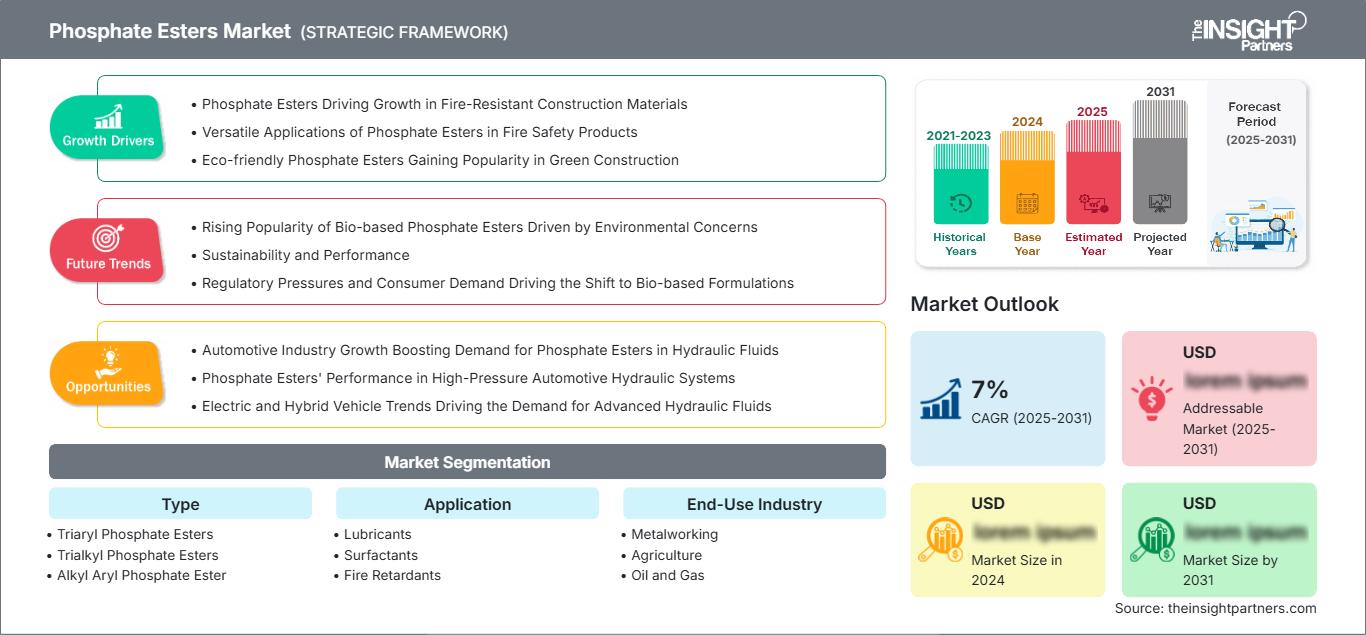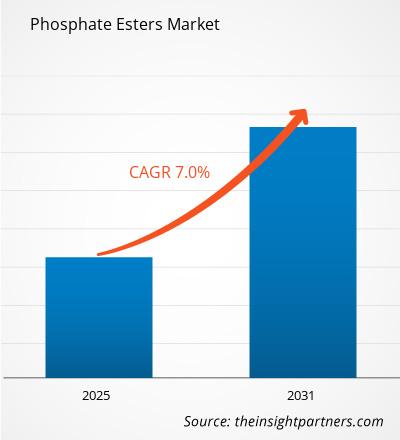Der Markt für Phosphatester wird voraussichtlich zwischen 2025 und 2031 eine durchschnittliche jährliche Wachstumsrate (CAGR) von 7 % verzeichnen, wobei die Marktgröße von XX Millionen US-Dollar im Jahr 2024 auf XX Millionen US-Dollar im Jahr 2031 anwachsen wird.
Der Bericht präsentiert eine Analyse nach Typ (Triarylphosphatester, Trialkylphosphatester, Alkylarylphosphatester und andere). Der Bericht ist nach Anwendung segmentiert (Schmiermittel, Tenside, Flammschutzmittel, Weichmacher, Korrosionsinhibitoren und andere). Der Bericht ist nach Endverbrauchsbranche segmentiert (Metallverarbeitung, Landwirtschaft, Öl und Gas, Kunststoff, Textil, Farben und Lacke und andere). Die globale Analyse ist weiter nach regionaler Ebene und wichtigen Ländern aufgeschlüsselt. Der Umfang umfasst die Marktgröße und -prognose auf globaler, regionaler und Länderebene für alle wichtigen Marktsegmente. Der Bericht bietet den Wert in USD für die oben genannte Analyse und Segmente. Der Bericht liefert wichtige Statistiken zum Marktstatus der wichtigsten Marktteilnehmer und bietet Markttrends und -chancen.
Zweck des Berichts
Der Bericht „Phosphatester-Markt“ von The Insight Partners beschreibt die aktuelle Situation und das zukünftige Wachstum sowie die wichtigsten treibenden Faktoren, Herausforderungen und Chancen. Dadurch erhalten verschiedene Geschäftsinteressenten Einblicke, wie z. B.:
- Technologieanbieter/-hersteller: Um die sich entwickelnde Marktdynamik zu verstehen und die potenziellen Wachstumschancen zu erkennen, damit sie fundierte strategische Entscheidungen treffen können.
- Investoren: Um eine umfassende Trendanalyse hinsichtlich der Marktwachstumsrate, der finanziellen Marktprognosen und der Chancen entlang der Wertschöpfungskette durchzuführen.
- Regulierungsbehörden: Um Richtlinien und Überwachungsaktivitäten auf dem Markt zu regulieren, mit dem Ziel, Missbrauch zu minimieren, das Vertrauen der Investoren zu wahren und die Integrität und Stabilität des Marktes aufrechtzuerhalten.
Phosphatester Marktsegmentierung Typ
- Triarylphosphatester
- Trialkylphosphatester
- Alkylarylphosphatester
Anwendung
- Schmiermittel
- Tenside
- Flammschutzmittel
- Weichmacher
- Korrosionsinhibitoren
Endverbraucherindustrie
- Metallverarbeitung
- Landwirtschaft
- Öl und Gas
- Kunststoff
- Textil
- Farben und Beschichtungen
Geographie
- Nordamerika
- Europa
- Asien-Pazifik
- Süd- und Mittelamerika
- Naher Osten und Afrika
Sie erhalten kostenlos Anpassungen an jedem Bericht, einschließlich Teilen dieses Berichts oder einer Analyse auf Länderebene, eines Excel-Datenpakets sowie tolle Angebote und Rabatte für Start-ups und Universitäten.
Markt für Phosphatester: Strategische Einblicke

-
Holen Sie sich die wichtigsten Markttrends aus diesem Bericht.Dieses KOSTENLOSE Beispiel umfasst Datenanalysen, die von Markttrends bis hin zu Schätzungen und Prognosen reichen.
Wachstumstreiber auf dem Phosphatester-Markt
- Phosphatester treiben das Wachstum bei feuerbeständigen Baumaterialien voran: Die stark zunehmende Verwendung von Phosphatestern als Flammschutzmittel in Baumaterialien treibt das Wachstum des Phosphatester-Marktes voran. Bauherren und Hersteller suchen nach einer effizienten Lösung, um die Feuerbeständigkeit ihrer Materialien zu verbessern, da die Brandschutzbestimmungen immer strenger werden. Phosphatester sind für ihre wirksame Verbesserung des Brandschutzes bekannt.
- Vielseitige Anwendungen von Phosphatestern in Brandschutzprodukten: Diese Verbindungen finden eine Reihe von Anwendungen, unter anderem in Kunststoffen, Beschichtungen und Textilien. Die hergestellten Baumaterialien bieten Schutz vor Hitze und zersetzen sich zu schützenden Kohleschichten, die die Ausbreitung von Flammen stoppen. Aufgrund dieser Eigenschaften wird der Phosphatester-Markt häufig im Bauwesen eingesetzt. Die steigende Nachfrage nach feuerbeständigen Materialien war einer der Hauptfaktoren für das Wachstum des Phosphatester-Marktes.
- Umweltfreundliche Phosphatester werden im grünen Bauen immer beliebter: Auch die Baubranche erlebt Veränderungen im Bereich der Umweltfreundlichkeit. Dies wirkt sich auf die Marktkräfte aus, da die Nachfrage nach Phosphatestern steigt, da diese weniger giftig sind und im Vergleich zu anderen verfügbaren Flammschutzmitteln geringere Umweltauswirkungen haben. Aus diesem Grund rücken umweltfreundliche Alternativen in den Fokus der Hersteller, was den Marktanteil von Phosphatestern aufgrund ihrer sichereren Eigenschaften erhöht.
Zukünftige Trends auf dem Phosphatester-Markt
- Steigende Beliebtheit von biobasierten Phosphatestern durch Umweltbedenken: Biobasierte Phosphatester erfreuen sich großer Beliebtheit und entwickeln sich schnell zu einem wichtigen Trend auf dem Phosphatester-Markt. Zunehmende Umweltbedenken und die zunehmende Bedeutung von Nachhaltigkeit veranlassen Hersteller dazu, erneuerbare Ressourcen zur Herstellung von Phosphatestern zu verwenden und so die Abhängigkeit von nicht erneuerbaren fossilen Brennstoffen zu reduzieren, was dem allgemeinen Druck entspricht, umweltfreundlichere Alternativen zu finden.
- Nachhaltigkeit und Leistung: Diese biobasierten Phosphatester behalten ähnliche Eigenschaften wie ihre erdölbasierten Gegenstücke, wodurch sie in vielen Anwendungen eingesetzt werden können, darunter Flammschutzmittel, Weichmacher und Schmiermittel. Ihre Anwendung führt zu einer Wertsteigerung des Produkts bei gleichzeitiger Minimierung der Umweltbelastung, wodurch das Produkt in Märkten, in denen Nachhaltigkeit und Sicherheit im Vordergrund stehen, positiv positioniert wird.
- Regulatorischer Druck und Verbrauchernachfrage treiben die Umstellung auf biobasierte Formulierungen voran: Ein weiterer Druck ist das regulatorische Umfeld, das Hersteller zu biobasierten Formulierungen drängt. Das Problem inakzeptabler Mengen schädlicher Chemikalien in Verbraucherprodukten führt zu einem zunehmenden regulatorischen Druck auf die Hersteller, die Verwendung solcher schädlichen Chemikalien vollständig zu vermeiden. Biobasierte Phosphatester versprechen eine solche Alternative zu sein, um diese ständig steigenden Anforderungen zu erfüllen. Ein solcher Ansatz erfüllt nicht nur die internen Compliance-Anforderungen, sondern reagiert auch auf die Nachfrage der Verbraucher nach umweltfreundlichen Produkten.
Marktchancen für Phosphatester
- Wachstum in der Automobilindustrie steigert die Nachfrage nach Phosphatestern in Hydraulikflüssigkeiten: Das Wachstum in der Automobilindustrie bietet enormes Wachstumspotenzial für den Phosphatestermarkt, insbesondere für Hydraulikflüssigkeiten. Moderne Fahrzeuge sind komplex, und dies führt zu einer wachsenden Nachfrage nach Hydraulikflüssigkeiten, die gleichzeitig Effizienz und Sicherheit bieten. Phosphatester sind für ihre bemerkenswerte Schmier- und Wärmestabilität bekannt.
- Leistung von Phosphatestern in Hochdruck-Hydrauliksystemen von Kraftfahrzeugen: Aufgrund ihrer Eigenschaften eignen sich Phosphatester für den Einsatz in hydraulischen Fahrzeugsystemen, einschließlich Lenkkraft, Bremsen und Aufhängung. Phosphatester zeigen unter derart hohen Drücken und Temperaturen ihre beste Leistung, was eine zuverlässige Funktion in modernen Kraftfahrzeugen erfordert. Diese erhöhte Nachfrage im Automobilsektor führt direkt zu Marktwachstum.
- Trends bei Elektro- und Hybridfahrzeugen treiben die Nachfrage nach modernen Hydraulikflüssigkeiten: Die zunehmende Nutzung von Elektro- und Hybridfahrzeugen treibt die Nachfrage nach modernen Hydraulikflüssigkeiten weiter an. Phosphatester bieten mit diesen leistungsstarken und umweltfreundlichen Anwendungen eine wettbewerbsfähige Position, insbesondere in anspruchsvollen Fahrzeugsystemen, die hocheffiziente Hydrauliklösungen erfordern.
Regionale Einblicke in den Phosphatester-Markt
Die Analysten von The Insight Partners haben die regionalen Trends und Faktoren, die den Phosphatestermarkt im Prognosezeitraum beeinflussen, ausführlich erläutert. In diesem Abschnitt werden auch die Marktsegmente und die geografische Lage in Nordamerika, Europa, dem asiatisch-pazifischen Raum, dem Nahen Osten und Afrika sowie Süd- und Mittelamerika erörtert.
Umfang des Marktberichts über Phosphatester
| Berichtsattribut | Einzelheiten |
|---|---|
| Marktgröße in 2024 | US$ XX million |
| Marktgröße nach 2031 | US$ XX Million |
| Globale CAGR (2025 - 2031) | 7% |
| Historische Daten | 2021-2023 |
| Prognosezeitraum | 2025-2031 |
| Abgedeckte Segmente |
By Typ
|
| Abgedeckte Regionen und Länder |
Nordamerika
|
| Marktführer und wichtige Unternehmensprofile |
|
Dichte der Marktteilnehmer für Phosphatester: Verständnis ihrer Auswirkungen auf die Geschäftsdynamik
Der Markt für Phosphatester wächst rasant, angetrieben durch die steigende Endverbrauchernachfrage aufgrund von Faktoren wie veränderten Verbraucherpräferenzen, technologischem Fortschritt und einem stärkeren Bewusstsein für die Produktvorteile. Mit steigender Nachfrage erweitern Unternehmen ihr Angebot, entwickeln Innovationen, um den Verbraucherbedürfnissen gerecht zu werden, und nutzen neue Trends, was das Marktwachstum weiter ankurbelt.

- Holen Sie sich die Markt für Phosphatester Übersicht der wichtigsten Akteure
Wichtige Verkaufsargumente
- Umfassende Abdeckung: Der Bericht analysiert umfassend Produkte, Dienstleistungen, Typen und Endnutzer des Phosphatester-Marktes und bietet einen ganzheitlichen Überblick.
- Expertenanalyse: Der Bericht basiert auf dem umfassenden Verständnis von Branchenexperten und Analysten.
- Aktuelle Informationen: Der Bericht gewährleistet Geschäftsrelevanz durch die Berichterstattung über aktuelle Informationen und Datentrends.
- Anpassungsoptionen: Dieser Bericht kann an spezifische Kundenanforderungen angepasst werden und passt sich optimal an die Geschäftsstrategien an.
Der Forschungsbericht zum Phosphatester-Markt kann daher dazu beitragen, die Branchensituation und die Wachstumsaussichten zu entschlüsseln und zu verstehen. Obwohl es einige berechtigte Bedenken geben kann, überwiegen die Vorteile dieses Berichts tendenziell die Nachteile.
- Historische Analyse (2 Jahre), Basisjahr, Prognose (7 Jahre) mit CAGR
- PEST- und SWOT-Analyse
- Marktgröße Wert/Volumen – Global, Regional, Land
- Branchen- und Wettbewerbslandschaft
- Excel-Datensatz
Aktuelle Berichte
Erfahrungsberichte
Grund zum Kauf
- Fundierte Entscheidungsfindung
- Marktdynamik verstehen
- Wettbewerbsanalyse
- Kundeneinblicke
- Marktprognosen
- Risikominimierung
- Strategische Planung
- Investitionsbegründung
- Identifizierung neuer Märkte
- Verbesserung von Marketingstrategien
- Steigerung der Betriebseffizienz
- Anpassung an regulatorische Trends






















 Kostenlose Probe anfordern für - Markt für Phosphatester
Kostenlose Probe anfordern für - Markt für Phosphatester